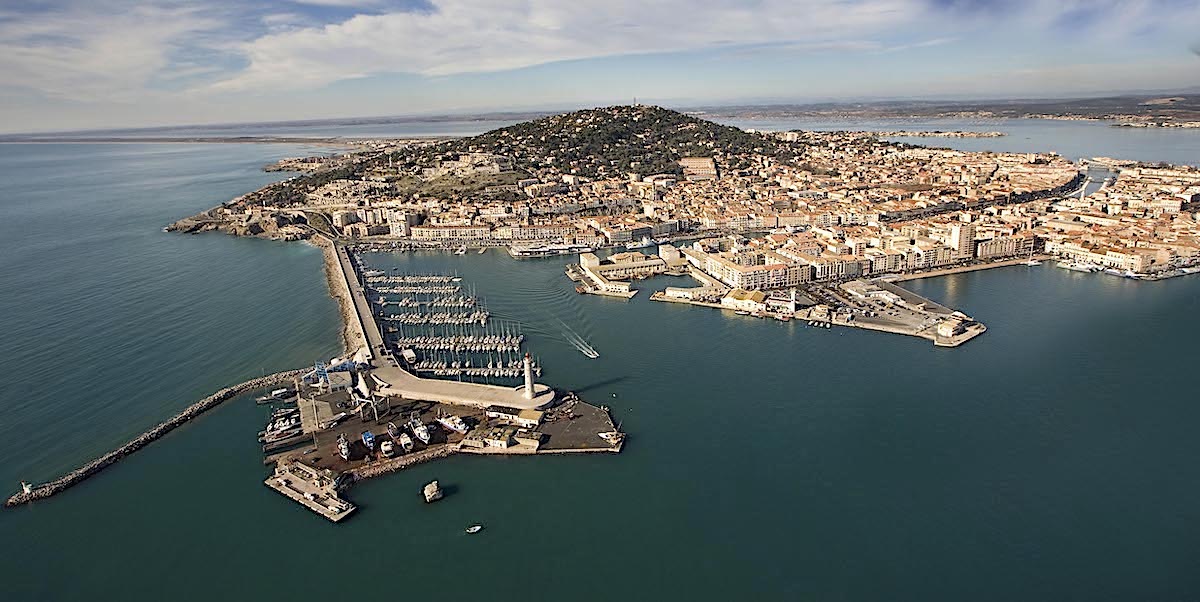
Aerial view of Sète showing the Lagoon of Thau and many of the seaside city’s canals. Photo by Olivier Maynard
By Jacqueline Swartz
The Mediterranean seaside playground of the Cote d/Azur has long been known for its exclusive nightclubs, pricey restaurants and tanned and toned beach bodies. There’s the star-studded film festival at Cannes, and sexy St. Tropez, popularized by Brigitte Bardot, perhaps the original influencer.
But 190 miles west, and a 20-minute train ride from Montpellier, there is another Mediterranean coastal paradise – Sète. It is the largest fishing port on the French Mediterranean, supplying sea bream, tuna, clams, mussels, and ten percent of the country’s oysters. The city often is compared to Venice because of its canals, which are lined with houses, shops and restaurants. Beyond the canals and central business district are dreamy lagoons and 12 km of protected beaches
Telenovelas Tell the Story
Sète has long attracted artists searching for a quiet, sunny, seaside place to vacation and work. The late film director, Agnes Varda, had a home here, and named her first film after the fisherman’s neighborhood called La Pointe-Courte, with its tumbledown houses, alleys and nets drying outside. Catherine Deneuve and other French stars have visited and made films here, so it isn’t totally unknown. But in the last five years, Séte has attracted a tsunami of French visitors, thanks to popular telenovelas that feature the place. With abundant sunshine, natural beauty, beaches, boating and diving, Sète offers the pleasures of other seaside destinations, “but with a supplement of soul,” remarks French actress, Ingrid Chauvin, who stars in “Tomorrow is Ours”, a soap opera located in Sète and now in its sixth season.
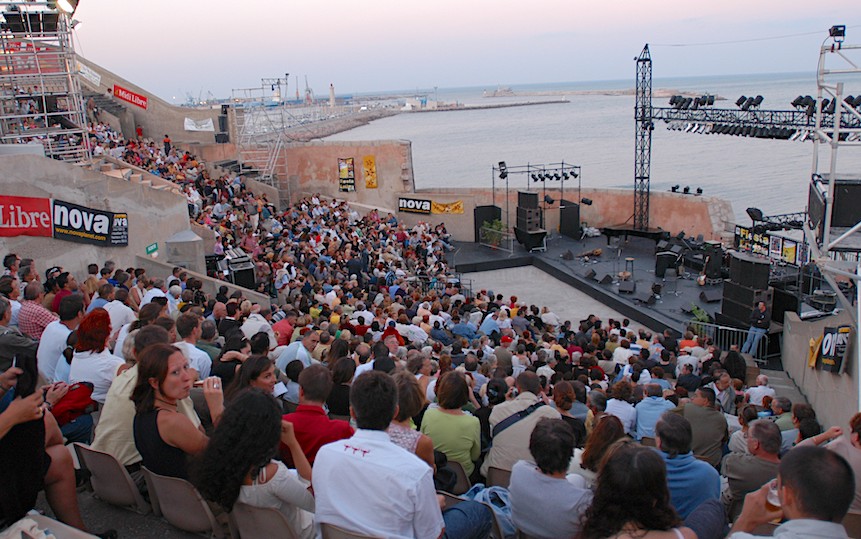
At the Theatre de la Mer (theater of the sea) you can see a musical performance while gazing out at the Mediterranean. Originally called Fort St. Pierre, the site was built in 1710 to prevent attacks from British ships. Photo by Andres Medel
With its fishermen prosperous, its oyster beds thriving, and its festivals attracting large crowds, Sète has become a vacation destination. But here you don’t dress up.
“We are the opposite of the Cote D’Azur,” insists Marie-France Parra, in charge of media relations for Sète and nearby beach towns. “We don’t show off.” Here centuries-old traditions continue with or without tourists.
Jousting on the water
Sète’s most enduring tradition is called joute – think of medieval jousting contests but with row boats instead of horses. From June to September, the players clash in the waters of the canals. The boats are powered by rowers, and jousters compete by standing on a horizontal ladder and wielding a lance and a shield. Losers fall into the water. Viewers line the canals and applaud. The mayor makes speeches and the winners are heralded long after the games are over. In Sète, tradition endures. Parents send their boys to jousting schools and in some families the players span several generations.
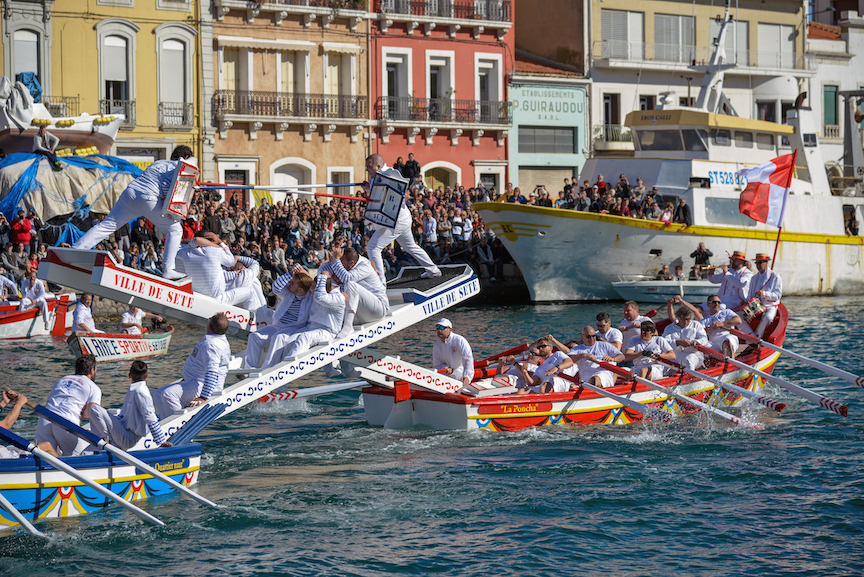
Joute combatants use lances and shields to push their opponents into the water. The tournament starts with a salutation of the jousters. They display their lances and shake hands when their boats cross. Photo by Jean-Pierre Degas
The sport goes back to the very founding of Sète. In 1666, Louis XIV, the Sun King, had what was considered a grandiose vision of linking the Canal du Midi, which was essential in floating goods from Toulouse to Sète on the Mediterranean Sea. On the 29th of July, the port of Sète was inaugurated and joute was part of the celebration.
Lower Town: shops, canals and other waterways
The canals are part of the so-called lower town, which is criss-crossed by bridges. There are other kinds of aquatic spaces that largely consist of a string of salt-water lagoons running parallel to the Mediterranean coast. The largest is called Etang or Basin of Thau.
A boat cruise is a great way to experience the idyllic waterways of Sète, and many leave from the harbor. Whether the cruise is 45 minutes or longer, it’s exhilarating to breathe the sea air of the Thau lagoon. Beyond are the picturesque canals lined with boats and punctuated by bridges. Beyond that are the glittering blue waters of the Mediterranean.
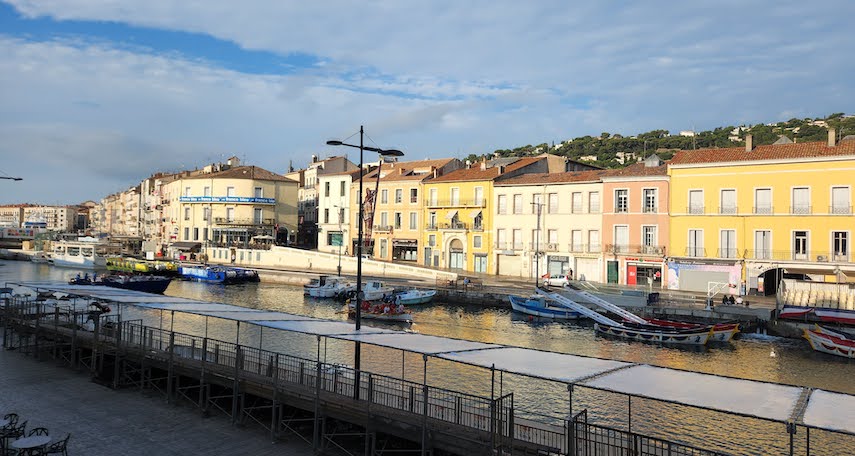
On the Sete canals you can see various kinds of boats, from fishing craft to motor boats, from row boats to the boats used by the Sete jousters. Viewing stands will soon be filled with spectators. Photo by Jacqueline Swartz
You can rent almost any kind of boat, everything from a yacht to a sea kayak. Water in the lagoons is incredibly clean, so dive right in. One of the underwater attractions is a tiny sea horse that is found in Sète and a few other places in Europe. Long threatened because of its use in Chinese Medicine, it often is dried and sold as a souvenir in tourist stores. But not in Sète. Here it is highly protected.
The center of the lower town is Place Aristide Briant, marked by a large stage. During the summer, one music festival follows another, with French chanson, world music and jazz, played on various stages and in bars. There are impressive musical roots: George Brassens, one of France’s most lauded singer songwriters, was born here and wrote a song that translates into ‘bury me on the beach in Sète.’ Manitas de Plata, the flamenco legend, grew up in a gypsy camp here.
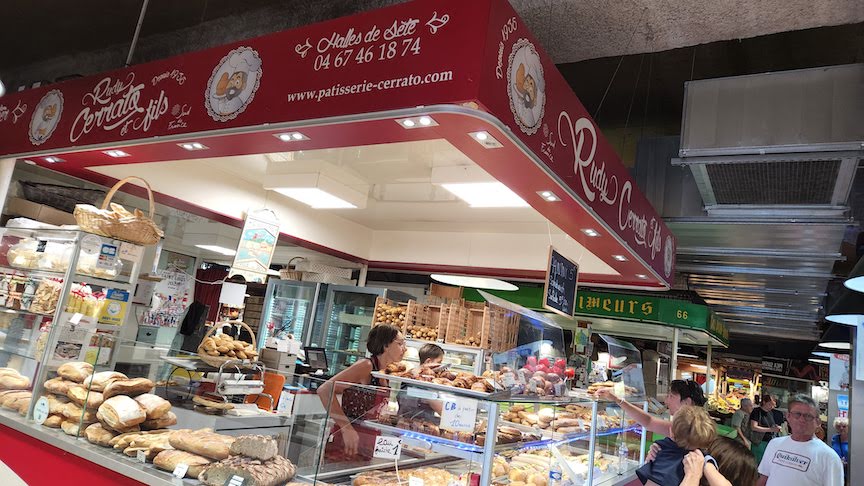
Les Halles Market. The bounty of the Mediterranean is on full display at Les Halles, Sète’s colorful market. Bread, cheese, olive oil are staples, along with lots of fish. Locals are drawn to the market to shop and to have lunch. Photo by Jacqueline Swartz
Nearby, on rue Gambetta is Les Halles, the food halls. Locals come here for the fresh and varied selection of fish, fruits and vegetables, olives and cheese. And there are several cafes. Don’t miss the signature dish of Tielle, a kind of pie traditionally filled with octopus, tomatoes, garlic and rosemary. It began as a convenient way for fishermen to take their lunch to work and is part of the Italian heritage in Sète. Now it holds a central place in the annual Festival of Gastronomy.
At the end of rue Gambetta is the Place du Pouffre, a verdant square with a fountain featuring a statue of an octopus; it could be Sète’s spirit animal.
Starting out from Les Halles, you’ll find streets full of shops The vintage store called Simone & Lucette, sells everything from fancy dresses and jeans to jewelry in an atmosphere of whimsy and discovery. Tchetine, whose slogan is ‘fashion ahead of fashion’ offers high-end French and Italian clothes.
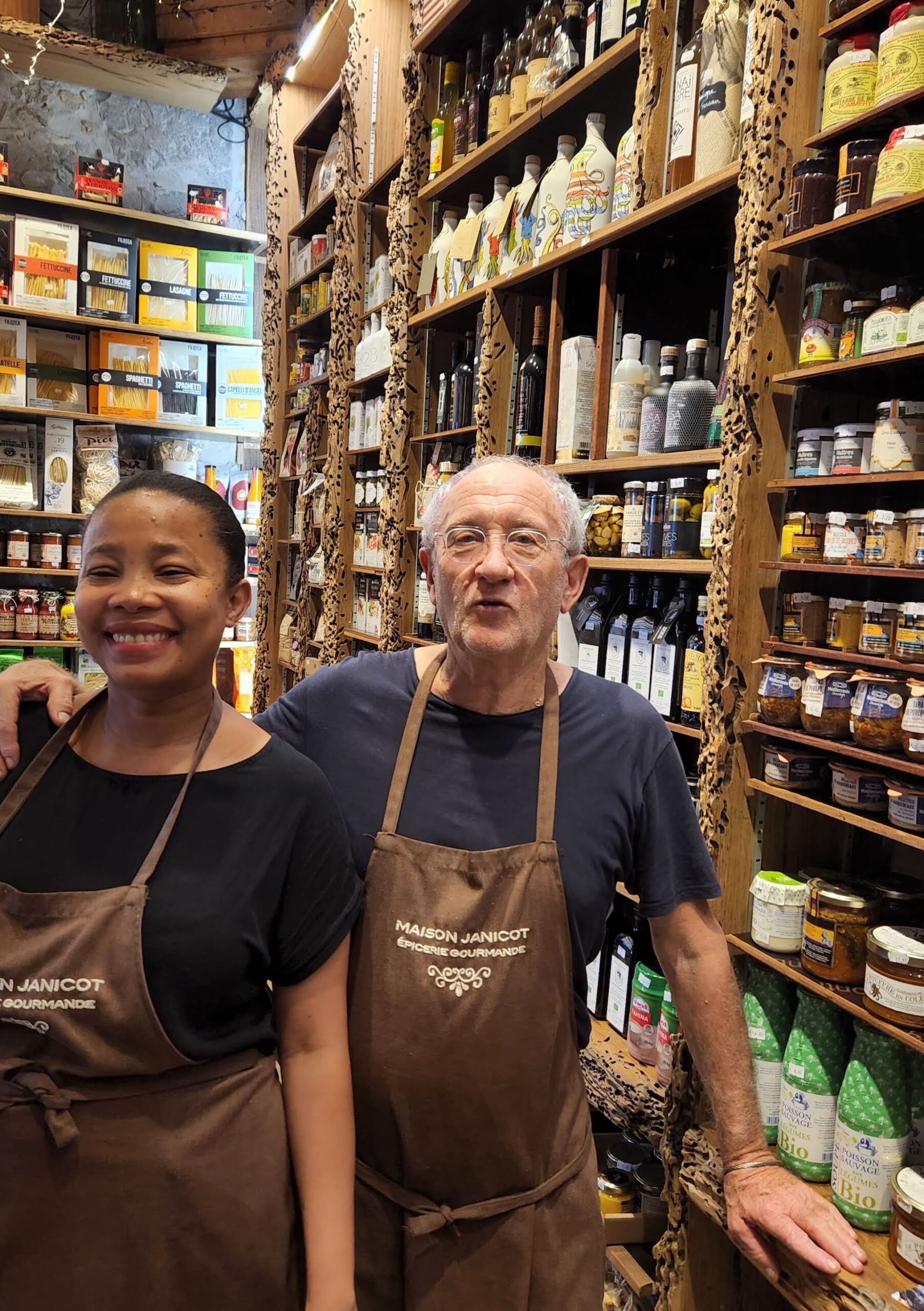
At Maison Janicot, a popular Sète épicerie, Gerard Janicot and his manager sell groceries ranging from wine to salami, from sardines to the popular local cookies called zezettes. Photo by Jacqueline Swartz
Maison Janicot is a colorful épicerie, a grocery store and deli carrying everything from anchovies to salami, from mustard to the local cookies known as zezettes. Gerard Janicot, the owner, points out that the usually well-stocked shelves of mustard are less than full. “It’s the fault of Canada,” he says. (Most of the West’s mustard seeds come from Canadian fields, and the recent harvest was meager.
Upper town
Sète is built around Mont St. Clair, which you can reach by an uphill one-hour walk, bus or tour. Once there, you’ll be rewarded by a panoramic view of the city and the sea – the canals, the port and the long ribbon of sand marking the beach. Nearby, The Paul Valery (1871-1945) Museum displays documents relating to the poet, essayist and artist and a collection of 20th century paintings, many inspired by Sète. There’s a café and a lush outdoor terrace with a great view.
Part way down the mountain is the Quartier Haute. The oldest district in Sète, it is called Little Naples after the many fishermen who came from the Amalfi Coast in the mid-1800s. In recent years, artists have opened studios on the hilly streets.
Lora Loilleux was born in Bulgaria and studied at the Beaux Arts Academy in Paris. When she moved to Sète, she turned to painting oyster and sea shells. “I was inspired by the imperfections, by the pleasure of picking up a shell and transforming it,” she says, surrounded by the shells and the earrings, rings, necklaces and hair ornaments displayed in her small gallery.
Sète and beyond – the Archipelago of Thau
Sète is part of the Archipelago of Thau, which includes 13 other neighboring towns. One, Marseillan, is linked to Séte by an eight-mile-long sandy beach. It’s an inviting place, with pastel-colored houses, shops and a dock filled with pleasure boats. What a surprise to find that it is also the home of Noilly Prat vermouth. The large facility has a theatre, tasting rooms and vats full of what remains America’s favorite vermouth. If you’re there for one of the film nights, you might see one starring James Bond. “Shaken, not stirred,” was his famous direction for making a martini with gin and Noilly Prat vermouth.
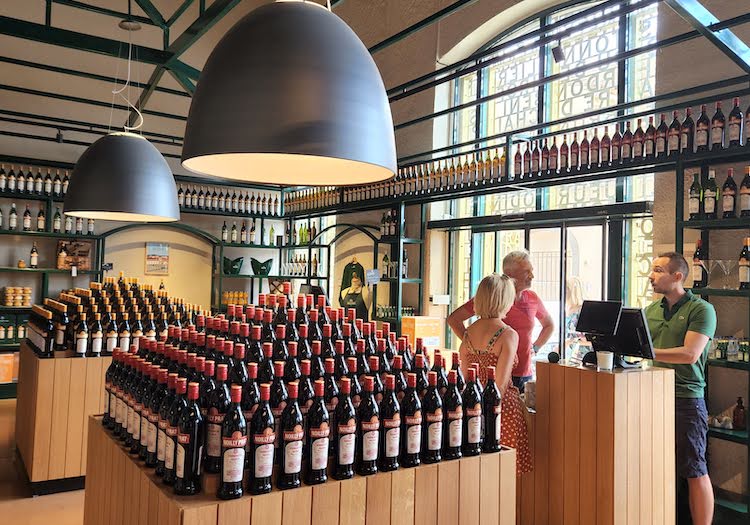
At the Noilly Pratt store, visitors can buy several types of Noilly Pratt fine local white wines fortified with alcohol. After fermentation, herbs and spices are added. There are usually four kinds. Ambre is one that is not always available at liquor stores, which most commonly carry Dry and Extra Dry, especially outside of France. In 1844, Joseph Noilly sent a case of his vermouth to Louisiana. New York followed, and today the label is as familiar in North America as it is in France. Photo by Jacqueline Swartz
On one of the tours, bilingual guide Pascal Bertolotto tells the story of the vermouth’s origins. Joseph Noilly created French vermouth in 1845 and the brand was created a decade later with partner Claude Prat.
“At that time, it was hard to find spices, but Joseph Noilly was a spice trader and herbalist,” recounts Bertolotto, adding that the bittersweet fortified wine was the first vermouth in France. Local white wines are used to make vermouth. Most of the grapes are from the nearby Languedoc region which is known for its vineyards.
Among the vats are bins of dried herbs and spices, and you can sniff orange peel, cloves, nutmeg, coriander and many others. The tour ends with a tasting of four kinds of vermouth. In addition to the classic Dry and Extra Dry, with its bitter taste, there is Amber, which has notes of rosebud, lavender, vanilla and orange peel. Rouge is sweeter and contains 29 herbs and spices including cloves and cocoa beans. Each one, no matter how bitter or sweet, has an unmistakable herbal taste.
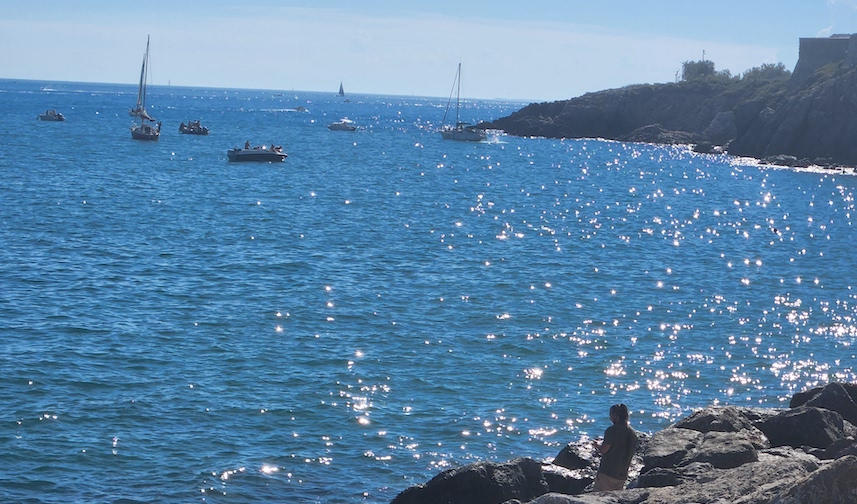
Among the many nautical pleasures Sète offers on the Lagoon of Thau are fishing, boating and simply enjoying the sea air. Photo by Jacqueline Swartz
Seafood by the sea shore
During the summer, open-air beachside restaurants draw locals and tourists. On the beach extending from Sète to Marseillan, La Voile Rouge is a popular, friendly place with an extensive menu specializing in fish. One of the combination plates includes sea bream, fresh tuna and mackerel. A Mediterranean Salad is also worth trying, with fresh tuna, tomato, marinated peppers, olives, lettuce and deviled egg.
For lovers of oysters, the ultimate seashore dining experience is found on the shores of the Lagoon of Thau’s oyster beds. Atelier & Co started out as a place to sort oysters from the nearby oyster beds. It still is, but now there are tables facing the sea and diners can feast on raw and cooked oysters and mussels cooked in a paella pan over a fragrant wood fire. When you sit down you are served crusty bread and olive tapenade – that’s it. You await your order of shellfish, with the only sounds coming from the sea and the appreciative murmurs of people seated nearby. The wines are local, and the classic pairing is Picpoul, a citrusy dry white grown nearby. There’s nothing like dining in this rustic, authentic place while the sun sets.
Another exceptional waterfront restaurant, The Marcel, faces the Canal Royale in the middle of the city. The only restaurant in Sète with a Michelin star, its 35-year-old chef, Denis Martin, is enthusiastic as he talks about using the bounty of the Mediterranean for his imaginative dishes. “I respect fishermen, I’m friends with them,” he says, adding that all the ingredients are local. Boasts Martin: “I can do an entire vegetarian menu that even non-vegetarians like.”
Martin uses herbs rather than spices. On one of the tasting menus, swordfish is accompanied by saltimbocca, leeks grilled on the barbecue, and a fish sauce with Noilly Prat Ambre vermouth.
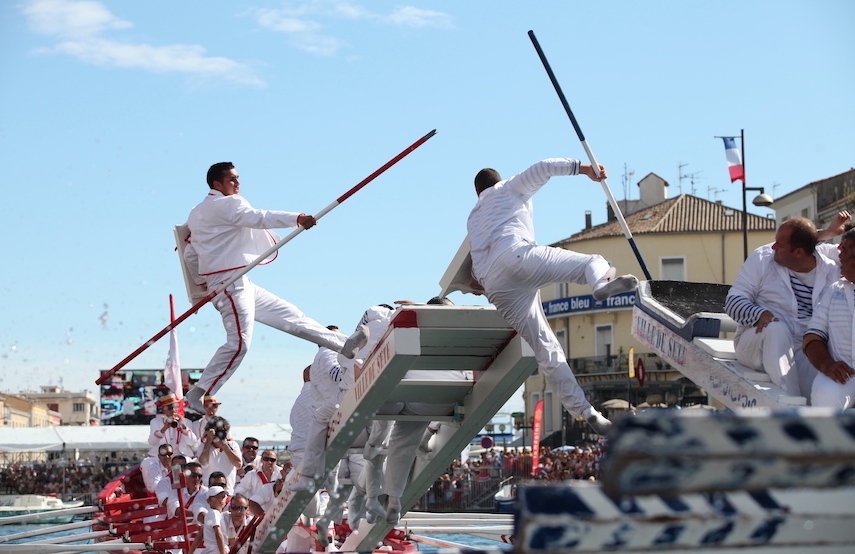
A Sète joute often ends with both combatants being knocked into the water. Fortunately, both live to fight another day. Photo courtesy of Sète Office of Tourism
A five-minute walk away is The Museum of Modest Arts. It’s an eccentric place, featuring objects you’d never expect to see in a museum. From Barbie dolls to snow globes, a “Modest Garden” made up of weeds, to collages using everything from mustard containers to tools found in a garage, these objects have a kind of unexpected creative energy. Very much like Sète itself.
If you go: Sete is accessible by train – a few hours from Paris, about 20 minutes from Montpellier. There is an airport at Toulouse and smaller ones nearby. Once you are in Sète and the Archipelago of Thau, there are a variety of tours. Vineyards are nearby, boats are available, and some food tours cover the region. You can contact the Office of Tourism by going to 60 Grand Rue Mario-Roustan 34200, or calling +33 (0) 99047171.![]()
Francophile Jacqueline Swartz has written about French philosophers, Provence and more. For EWNS her stories include features on Vienna, Toronto, Romania, the Dead Sea Scrolls and the Ethics of travel writing.

